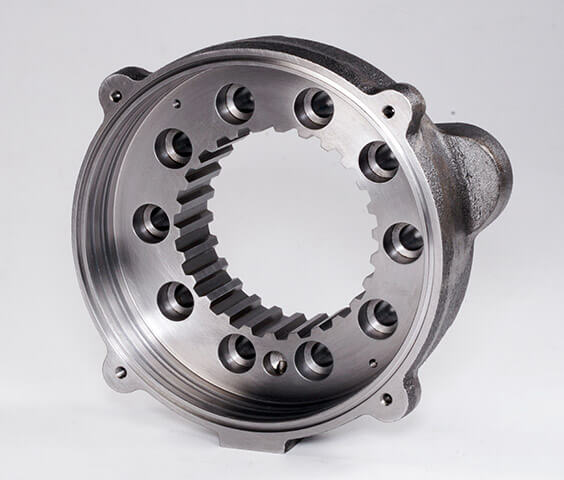Casting is an essential manufacturing process employed across various industries to craft products of intricate designs and diverse shapes.
Aluminium Casting vs. Steel Casting
This versatile method breathes life into complex ideas and enables the creation of products that we interact with daily. When it comes to casting, two stalwart materials take center stage: steel and aluminium.
Renowned for their strength, durability, and aesthetic appeal, these materials are the linchpin for many manufacturers seeking to produce exceptional products.

But each comes with its unique set of advantages and disadvantages, sparking a perennial debate about which alloy reigns supreme.
The choice between aluminium and steel casting hinges on a careful evaluation of their properties, ensuring they align with the product’s intended purpose.
Let’s embark on a comparative journey through the properties of these two casting materials:
1. Strength
Steel, as a general rule, boasts superior strength when compared to aluminium.
However, it’s essential to note that steel is not the zenith of strength among metals.
When a product necessitates robust structural integrity, steel emerges as a prime candidate.
It finds applications across a multitude of industries and uses cases.
While aluminium is also robust, it typically ranks slightly lower than steel in terms of sheer strength.
2. Weight
In the strength department, steel once again holds an advantage over aluminium.
It’s density and inherent strength make it the material of choice for products where weight-bearing capacity is a paramount concern.
However, this advantage often comes at the cost of increased overall product weight.
Aluminium, while strong, tends to lag in this regard but offers benefits such as reduced weight, which can be advantageous in various applications.
3. Corrosion Resistance
Corrosion Resistance is a critical factor in product longevity, particularly in environments exposed to moisture.
Steel, though susceptible to rusting, varies in its susceptibility based on its type. For instance, carbon steel is prone to rusting, while stainless steel offers commendable corrosion resistance.
On the other hand, aluminium is inherently more corrosion-resistant than steel, making it an optimal choice for products intended for use in moist or wet conditions.
For rust-free longevity, aluminium casting often takes precedence.
4. Cost
The cost factor fluctuates depending on multiple variables, including the type of casting, product complexity, material quality, and brand or manufacturer.
Both steel and aluminium castings can potentially be expensive, especially when premium alloys are involved.
The ultimate cost often hinges on the intricacy of the product, the material’s quality, and the manufacturer’s reputation.
5. Heat Strength
Heat strength is a crucial consideration, particularly when products will operate in high-temperature environments.
Here, steel casting typically has the upper hand. Aluminium’s lower melting point renders it less suitable for high-heat applications.
If a product will encounter elevated temperatures, steel casting is the recommended choice to ensure the material retains its structural integrity.
6. Workability
The casting process doesn’t culminate with the creation of the cast; there are often additional machining and finishing processes involved.
Aluminium holds an edge in terms of workability. It melts at lower temperatures, making it more malleable and easier to pour into moulds.
Its pliability also simplifies the machining and finishing processes.
Conversely, steel castings are stiffer, necessitating more effort during machining and finishing.
To make an informed decision regarding the ideal casting material for a specific product, meticulous consideration of these properties is paramount.
Applications of Aluminium Casting vs. Steel Casting
Both aluminium and steel castings find applications across a spectrum of industries, underlining their versatility and utility.
Aluminium Casting Applications:
- Aerospace: Aluminium castings have a long-standing history in the aerospace industry, thanks to their unique combination of strength and lightweight properties.
- Automotive: The automotive sector employs cast aluminium for various components, including water pump housings, oil pumps, transmission parts, connectors, and more. Aluminium’s lightweight, robust nature, and durability make it a prime choice for these applications.
- Heavy-Duty Equipment: Aluminium castings are utilized to craft brackets for heavy-duty equipment like crankcase housing, motor housing, and gearbox housings. They also play a role in the production of golf products and equipment, including golf ball warmers, grips, and clubs.
Steel Casting Applications:
- Food Processing: Steel castings find a niche in the food processing industry, where hygiene and durability are paramount. Components like metal grinder parts, coffee machines, oven parts, and more are often crafted from 304 and 306 stainless alloys.
- Kitchen and Cutlery: Kitchen and cutlery products such as spoons, forks, and knives frequently undergo the steel casting process due to their durability and resilience.
- Marine Industry: In the marine sector, steel castings are a go-to choice for crafting various components and equipment due to their resistance to corrosion in saltwater environments.
- Medical Equipment: Steel castings are integral to the production of medical supplies and tools, including surgical instruments, operating room equipment, operating tables, stretchers, wheelchairs, and more.
- Construction: A multitude of construction equipment, machinery, and components are forged through the steel casting process, thanks to its robustness and reliability.
The Verdict: Aluminium vs. Steel Casting
The choice between aluminium and steel casting is a multifaceted decision.
Both materials possess their unique strengths and weaknesses, rendering them equally effective in the creation of robust, long-lasting products across numerous industries.
For those less versed in materials engineering, consulting an expert is often the best course of action, ensuring the chosen material aligns precisely with the product’s intended application.
Ultimately, the success of a product hinges on the meticulous selection of the casting material, a decision that can significantly impact its performance, longevity, and overall quality.
